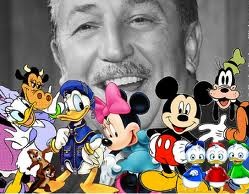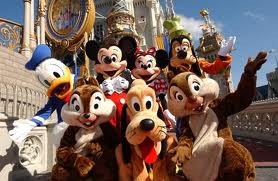Try to imagine a world without Walt Disney. A world without his magic, whimsy, and optimism. Walt Disney transformed the entertainment industry into what we know today. He pioneered the fields of animation and found new ways to teach and educate. He was a creator; an imaginative, and aesthetic person. Even 45 years after his death, we still continue to grasp his ideas, and his creations, remembering him for everything he's done for us.
试想一下,如果没有华特·迪士尼,没有他的神来之作、奇思妙想和乐观豁达,这个世界将是怎样的一个世界。华特·迪士尼一手将娱乐产业改造成了我们今天所熟知的模样。他开辟了动画领域的发展道路,找到了教导和培养(孩子)的新方法。他是一个创造者,一个富于想象力且颇具审美眼光的人。即便在他故去45年之后,我们仍然在不断领悟其思想和作品的实质,并因他为我们所做的一切而将他铭记于心。
Early Life
早年生活
 Walter Disney was born on December 5, 1901 in Chicago Illinois. He was raised on a farm in Marceline, Missouri and lived for most of his childhood here. He had a very early interest in drawing and art, and when he was seven years old he sold small sketches and drawings to nearby neighbors. His knack1) for creating enduring art forms took shape when he convinced his sister, Ruth, into helping him paint the side of the family's house with tar.
Walter Disney was born on December 5, 1901 in Chicago Illinois. He was raised on a farm in Marceline, Missouri and lived for most of his childhood here. He had a very early interest in drawing and art, and when he was seven years old he sold small sketches and drawings to nearby neighbors. His knack1) for creating enduring art forms took shape when he convinced his sister, Ruth, into helping him paint the side of the family's house with tar.
1901年12月5日,华特·迪士尼出生于美国伊利诺伊州芝加哥市。他在密苏里州马瑟林的一个农场长大,在那里度过了童年的大部分时光。华特很早就对绘画和艺术萌生了兴趣。七岁那年,他开始向附近的邻居出售小幅速写和素描画。在他说服姐姐露丝帮他给自家房屋外墙刷上柏油时,他已经初步掌握了创作经久不衰的艺术形式的技巧。
Close to the Disney family farm, there were Santa Fe Railroad tracks that crossed the countryside. Often Walt would put his ear against the tracks, to listen for approaching trains. Walt later worked a summer job with the railroad, selling newspapers, popcorn, and sodas to travelers. During his life Walt would often try to recapture the freedom he felt when aboard those trains by building his own miniature train sets.
在离迪士尼家农场不远的地方,有一条横穿乡村的圣菲铁路,华特常常把耳朵贴在铁轨上,聆听火车驶来的声音。后来,夏天的时候,华特就到铁路上打工,向游客出售报纸、爆米花和苏打水。在华特的一生中,他总是希望能够重新体验当年在火车上感到的那种自由,为此,他建造了属于自己的微型铁路模型。
During these “carefree years” of country living young Walt began to love and appreciate nature and wildlife; family and community, which were a large part of agrarian2) living. Though his father could be quite stern, and often there was little money, Walt was encouraged by his mother and older brother, Roy.
在乡下生活的那段“无忧无虑的岁月”里,年幼的华特爱上了大自然与野生动植物、家庭与社区这些田园生活的主要构成部分,对它们欣赏不已。虽然华特的父亲管教很严,而且家里的经济状况也常常捉襟见肘,但他却得到了母亲和哥哥罗伊的支持和鼓励。
Walt attended McKinley High School in Chicago where he divided his attention between drawing and photography, and contributing to the school paper. At night he attended the Academy of Fine Arts, to better his drawing abilities.
上了芝加哥麦金利高中后,华特把精力用在绘画、摄影和给校报投稿上。晚上,他还到美术学院上课,以提高自己的绘画技能。
Even after the Disney family moved to Kansas City, Walt continued to develop and flourish in his talent for artistic drawing. Besides drawing, Walt had picked up a knack for acting and performing. At school, he began to entertain his friends by imitating his silent screen hero, Charlie Chaplin. At his teacher's invitation, Walt would tell his classmates stories while illustrating on the chalk board.
就算后来迪士尼一家迁往了堪萨斯城,华特在绘画才能方面的发展和丰富也从未因此中断。除了绘画以外,华特还学会了表演技巧。上学期间,他开始通过模仿心目中无声电影的银幕英雄——查理·卓别林来为朋友们带去欢乐。在老师的邀请下,华特还会一边给同学们讲故事,一边在黑板上画故事插图。
Walt dropped out of high school at 17 to serve in World War I. Rejected because he was under age, Walt joined the Red Cross and was sent overseas to France, where he spent a year driving an ambulance and chauffeuring3) Red Cross officials. His ambulance was covered from stem to stern4), not with stock camouflage5) , but with Disney cartoons.
17岁那年,华特从高中辍学,入伍参加第一次世界大战。由于年龄达不到应征标准,华特转而加入红十字会,后来漂洋过海,被派往法国。在那里,他开了一年的救护车,还负责运送红十字会的官员。他的救护车并没有使用常用的伪装色,而是从头到尾都画满了迪士尼漫画。
Experiments in Animation
试水动画
Once Walt returned from France, he wanted to pursue a career in commercial art, which soon lead to his experiments in animation. By 1922, he had set up his own shop in association with Ub Iwerks, whose drawing ability and technical inventiveness were prime factors in Disney's eventual success. He began producing short animated films for local businesses, in Kansas City. By the time Walt had started to create The Alice Comedies, which was about a real girl and her adventures in an animated world, Walt ran out of money and his company, Laugh-O-Grams, went bankrupt. Instead of giving up, in August of 1923 Walt left Kansas City for Hollywood with nothing but a few drawing materials, $40 in his pocket and a completed animated and live-action film. He was not yet twenty-two. Walt's brother, Roy, who was already in California, provided support and $250. Pooling their resources, they borrowed an additional $500 and constructed a camera stand6) in their uncle's garage. Soon, they received an order from New York for the first Alice in Cartoonland (The Alice Comedies) featurette7) , and the brothers began their production operation in the rear of a Hollywood real estate office two blocks away.
从法国回来后,华特想要在商业艺术领域干出一番事业,在这一想法的推动下,他开始试着制作动画。到1922年时,他已经联手乌布·伊沃克斯开办了自己的公司,而迪士尼最终能取得成功,也主要得益于乌布·伊沃克斯的绘画才能与创作技巧。之后,华特开始在堪萨斯城为当地企业制作动画短片。等到开始创作《爱丽丝喜剧系列》——讲述一个现实中的女孩及其在动画世界里的奇遇——的时候,华特的资金用完了,他的“欢笑动画”公司也因此破产。华特并没有气馁,恰恰相反,1923年8月,他揣着仅有的40美元,带着几件绘图材料和一部已经完工的实景动画电影,离开堪萨斯城,奔向好莱坞。那时他还不到22岁。华特的哥哥罗伊当时已经在加利福尼亚,他向华特伸出援手,给了他250美元。他俩把手里的钱凑在一起,又借了500美元,在他们叔叔的车库里支起了摄像机支架。很快,兄弟二人就接到了从纽约发来的一张订单——第一部《爱丽丝在卡通国》(《爱丽丝喜剧系列》)短片电影。就这样,在好莱坞一家地产办公大楼后面相隔两条大街的地方,两人开始办起了自己的制片公司。
The Golden Age of Disney Cartoons
迪士尼动画的黄金时代
 On July 3, 1925, Walt married one of his first employees, Lillian Bounds, in Lewiston, Idaho. Later on they would be blessed with two daughters, Diane and Sharon. Three years after Walt and Lilly wed, Walt created a new animated character, Mickey Mouse. His talents were first used in a silent cartoon entitled Plane Crazy. However, before the cartoon could be released, sound was introduced upon the motion picture industry. Thus, Mickey Mouse made his screen debut in Steamboat Willie, the world's first synchronized sound cartoon featuring Disney as the voice of the Mouse. Living frugally, Walt reinvested profits to make better pictures. His insistence on technical perfection and his unsurpassed gifts as story editor quickly pushed his firm ahead. Technicolor8)was introduced to animation during the production of his Silly Symphonies cartoon features. Walt Disney held the patent for Technicolor for two years, allowing him to make the only color cartoons. In 1932, the production entitled Flowers and Trees won Walt the first of his studio's Academy Awards. In 1937, he released The Old Mill, the first short subject to utilize the multi-plane camera technique.
On July 3, 1925, Walt married one of his first employees, Lillian Bounds, in Lewiston, Idaho. Later on they would be blessed with two daughters, Diane and Sharon. Three years after Walt and Lilly wed, Walt created a new animated character, Mickey Mouse. His talents were first used in a silent cartoon entitled Plane Crazy. However, before the cartoon could be released, sound was introduced upon the motion picture industry. Thus, Mickey Mouse made his screen debut in Steamboat Willie, the world's first synchronized sound cartoon featuring Disney as the voice of the Mouse. Living frugally, Walt reinvested profits to make better pictures. His insistence on technical perfection and his unsurpassed gifts as story editor quickly pushed his firm ahead. Technicolor8)was introduced to animation during the production of his Silly Symphonies cartoon features. Walt Disney held the patent for Technicolor for two years, allowing him to make the only color cartoons. In 1932, the production entitled Flowers and Trees won Walt the first of his studio's Academy Awards. In 1937, he released The Old Mill, the first short subject to utilize the multi-plane camera technique.
1925年7月3日,华特与莉莲·邦兹在爱达荷州路易士顿市结婚,莉莲是他首批雇用的员工之一。后来,他们有了两个女儿——黛安娜和莎伦。与莉莲结婚三年后,华特创作了一个新的动画形象——米老鼠。在一部名叫《疯狂的飞机》的无声动画片中,米老鼠的才华第一次得以施展。然而,这部动画片还未上映,电影业就引进了声音。这样一来,米老鼠在影片《威利号汽船》中完成了其银幕首秀。这是世界上第一部拥有同步声音的动画片,片中的米老鼠由迪士尼配音。华特生活节俭,他用赚来的钱进行了再投资,希望能做出更好的动画片。他在技术上的务求完美和在编剧方面无与伦比的天赋迅速推动了公司的发展。在他制作动画故事片《糊涂交响曲》的过程中,动画业出现了“彩色印片法”。华特拥有“彩色印片法”为期两年的技术专用权,这意味着只有他才有权制作彩色动画。1932年,《花与树》一片为华特捧回了自己电影制片厂的第一个奥斯卡奖。1937年,华特发行了首部运用多平面摄像技术拍摄的短片——《老磨坊》。
The invention of cartoon characters as Mickey Mouse, Donald Duck, Minnie, and Goofy combined with the daring and innovative use of music, sound, and folk material made the Disney shorts of the 1930s a phenomenon of worldwide success. This success led to the establishment of immensely profitable, Disney-controlled sidelines9) in advertising, publishing, and franchised goods.
米老鼠、唐老鸭、米妮和高飞狗等卡通形象的创作,加上在音乐、声效和民俗材料方面的大胆和创新应用,让20世纪30年代的迪士尼动画短片享誉全球,其成就堪称奇迹。在这一成就的带动下,迪士尼旗下的广告、出版和特许商品等利润丰厚的附带产业也纷纷确立了自己的地位。
Disney rapidly expanded his studio facilities to include a training school where a whole new generation of animators developed and made possible the production of the first feature-length cartoon, Snow White and the Seven Dwarfs (1937).
迪士尼迅速对自己电影制片厂的设施进行了扩充,建起了一所培训学校,正是在这所学校里,新一代动画师不断成长,并制作了第一部动画长片——《白雪公主和七个小矮人》(1937年)。
In 1940, construction was completed on the Burbank Studio, and Disney's staff swelled to more than 1,000 artists, animators, story men, and technicians. But because of World War II, 94 percent of the Disney facilities were engaged in special government work, including the production of training and propaganda films for the armed services.
1940年,伯班克电影制片厂建设完成,迪士尼的工作班底扩大至一千多名,包括艺术家、动画师、编剧以及技术人员。然而,由于第二次世界大战的爆发,迪士尼94%的设备被用于特殊的政府工作,包括为武装部队制作培训和宣传影片。
Disney's 1945 feature, the musical The Three Caballeros, combined live action10)with the cartoon animation, a process he used successfully in such other features as Song of the South and the highly acclaimed Mary Poppins. Other costly animated features followed, including Pinocchio, Bambi, and the celebrated musical experiment Fantasia. With Seal Island (1948), wildlife films became an additional source of income, and in 1950 his use of blocked funds in England to make pictures like Treasure Island led to what became the studio's major product—live-action films. In 1954, Disney successfully invaded television.
1945年,迪士尼推出音乐故事片《三剑客》,该片采用了真人表演与卡通动画相结合的制作手法,华特将这种手法也成功地运用在《南方之歌》和深受好评的《欢乐满人间》等影片中。随后,迪士尼打造了几部高成本影片,包括《木偶奇遇记》、《小鹿斑比》以及名闻遐迩的音乐试验剧《狂想曲》。随着《海豹岛》(1948年)的上映,野生动物题材的影片成为迪士尼又一收入来源。1950年,华特利用在英国的冻结资金制作了诸如《金银岛》这样的影片,从此催生了迪士尼电影制片厂后来的主流产品——真人实景电影。1954年,迪士尼成功进军电视业。
Foundation of Disneyland, EPCOT and a University
制造快乐,实现梦想
 The idea for the Disneyland Park came to Walt after he took his children to other amusement parks and watched them have fun on amusement rides. He decided to build a park where the entire family could have fun together. Disney and his brother Roy mortgaged11) everything they owned to raise $17 million to build Disneyland, but fell short of what they needed. ABC-TV stepped in, guaranteeing a $6 million loan in exchange for part ownership and Disney's commitment to produce a weekly television show for them.
The idea for the Disneyland Park came to Walt after he took his children to other amusement parks and watched them have fun on amusement rides. He decided to build a park where the entire family could have fun together. Disney and his brother Roy mortgaged11) everything they owned to raise $17 million to build Disneyland, but fell short of what they needed. ABC-TV stepped in, guaranteeing a $6 million loan in exchange for part ownership and Disney's commitment to produce a weekly television show for them.
建造迪士尼乐园的想法源于华特的一次经历:他带着自己的孩子去别的游乐园玩耍,看到他们在旋转木马上玩得很开心,于是便萌生了自己创办乐园的念头。他决定建造一个可以让全家人共享天伦之乐的公园。为了建造迪士尼乐园,迪士尼和他的哥哥罗伊拿出所有家当作抵押,筹措到1700万美元,但仍旧没有达到所需数目。这时,美国国家广播公司电视台对他们施以援手,承诺出资600万美元。作为交换条件,他们将拥有迪士尼乐园的部分所有权,而且迪士尼还要保证为他们每周制作一期电视节目。
Disney engaged12)Stanford Research Institute, who identified Anaheim as the center of Southern California's future growth. Disney bought 160 acres of Anaheim orange groves, and on May 1, 1954, construction began. Walt Disney's dream of a clean, and organized amusement parkcame true as Disneyland Park opened in 1955 in Anaheim, California. As a fabulous $17-million magic kingdom, it soon increased its investment tenfold, and by the beginning of its second quarter-century had entertained more than 200 million people, including presidents, kings and queens, and royalty from all over the globe. Since then, Disney theme parks have opened in Orlando, Tokyo, Hong Kong and Paris.
迪士尼请来斯坦福研究所帮忙选址,他们认定阿纳海姆将成为南加利福尼亚未来的发展中心。于是,迪士尼便买下阿纳海姆160英亩的橘树林。1954年5月1日,迪士尼乐园开始动工。1955年,随着迪士尼乐园在加利福尼亚州阿纳海姆落成开放,迪士尼的梦想——拥有一个整洁干净、井井有条的游乐园——终于成真。作为一个以1700万美元巨额资金打造的奇幻王国,它很快就带来了十倍于投资的回报。到开放后的第二个25年时,迪士尼乐园已经接待了两亿多游客,其中不乏总统、国王、王后以及来自全球的王室贵胄。从那以后,迪士尼主题乐园又相继登陆奥兰多、东京、香港和巴黎。
In 1965, Walt Disney turned his attention toward the problem of improving the quality of urban life in America. He personally directed the design of an Experimental Prototype Community of Tomorrow (EPCOT). EPCOT, which cost an initial $900 million, was conceived of as a real-life community of the future with the very latest in high technology. The two principle areas of EPCOT are Future World and World Showcase, both of which were designed to appeal to adults rather than children.
1965年,华特·迪士尼开始将目光转向如何提升美国城市居民的生活质量。他亲自主持设计了“未来社会的试验模型”(EPCOT)。根据设想,仅启动就耗资9亿美元的EPCOT是一个包含最新高科技内容的未来的真实生活社区。EPCOT包括“未来世界”和“世界之窗”两个主要区域,两者的设计初衷都是招徕成年人而非儿童。
In addition to his theme parks, Disney created and endowed a new university, the California Institute of the Arts, known as Cal Arts. He thought of this as the ultimate in education for the arts, where people in many different disciplines could work together, dream and develop, and create the mixture of arts needed for the future.
除了主题乐园,迪士尼还捐资创建了一所大学,这就是加利福尼亚艺术学院,即人们所知道的加州艺院。在他看来,这里是艺术教育的极致化所在,诸多不同学科的人们可以在这里一起工作,一起梦想,一起开拓,共同创造出迎合未来所需、融汇百家之长的艺术作品。
Happily married for 41 years, this moody, deliberately “ordinary” man was moving ahead with his plans for gigantic new outdoor recreational facilities when he died of circulatory problems on December 15, 1966, at St. Joseph's Hospital in Los Angeles. At the time of his death, his enterprises had garnered13) him respect, admiration, and a business empire.
华特·迪士尼度过了41年幸福的婚姻生活,他情绪多变,总是故意以“普通人”的形象示人,就在他怀揣建造新型户外娱乐设施的梦想打算在人生路上继续前行时,却于1966年12月15日因循环系统疾病在洛杉矶圣约瑟夫医院溘然长逝。到他去世时,他所开创的事业为他带来的是尊重、崇拜和一个商业帝国。
Walt Disney is a legend; a folk hero of the 20th century. His worldwide popularity was based upon the ideals which his name represents: imagination, optimism, creation, and self-made success in the American tradition. Through his work he brought joy, happiness, and a universal means of communication to the people of every nation. He brought us closer to the future, while telling us of the past. It is certainthat there will never be such a great man as Walt Disney.
华特·迪士尼是一个传奇人物,是20世纪的平民英雄。他之所以能受到举世欢迎,是因为他的名字所代表的那些理想:想象力、乐观、创造力以及美国传统中自力更生的成功信条。他用他的努力给我们带来了欢乐和幸福,为各国人民提供了一个彼此沟通的途径。他给我们讲述的是过去,却由此让我们更贴近未来。毋庸置疑,伟大如华特·迪士尼者,将不会再有。
1. knack [næk] n. 技能,本领
2. agrarian [əˈɡreəriən] adj. 土地的,耕地的
3. chauffeur [ʃəʊˈfɜː(r)] vt. 开车运送
4. from stem to stern:完全,从头到尾
5. camouflage [ˈkæməˌflɑːʒ] n. 伪装,保护色
6. camera stand:摄像机支架
7. featurette [ˈfiːtʃəret] n. 电影短片
8. technicolor [ˈteknɪˌkʌlə(r)] n. 彩色印片法
9. sideline [ˈsaɪdˌlaɪn] n. 副业
10. live action:真人(或实景)电影
11. mortgage [ˈmɔː(r)ɡɪdʒ] vt. 抵押
12. engage [ɪnˈɡeɪdʒ] vt. 雇佣
13. garner [ˈɡɑː(r)nə(r)] vt. 获得,得到
